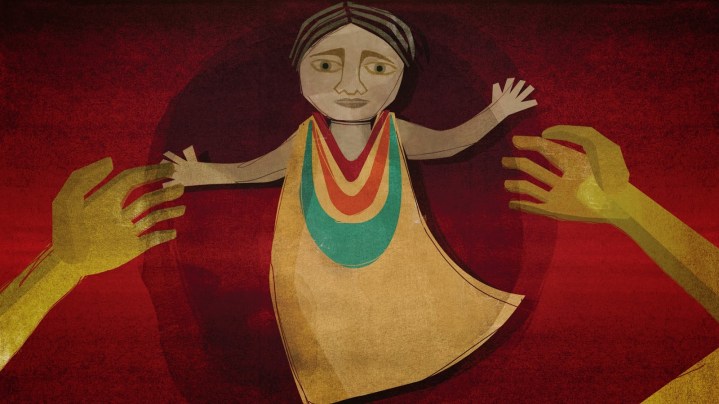1
Imagen de Prometeo / Prometheus' Image
Based on the story “Imagen de Prometeo” by Andrés Henestrosa
Language: Zapoteco from the Planicie Costera, Oaxaca

Screenshot courtesy of 68 voces
To residents of the Americas, Europe can seem like a tower of Babel with dozens upon dozens of languages crammed into a small geographical space and vying endlessly for dominance or survival. On this side of the world things are much simpler: English, Spanish, Portuguese, French, and a few Dutch speakers make communication generally much smoother across the continent, along with a few New World Patois thrown into the mix for good measure.
At least so the thinking goes. In reality, the American continent is a place of vast linguistic diversity, with more language families found solely in Mexico than in the entirety of the European continent. And with each language comes a particular vision of the world, an inimitable expressivity, a treasure trove of wisdom accrued over the centuries and codified in words and idioms.
Yet these languages struggle desperately for survival in the midst of a post-colonial landscape dominated by a small handful of European languages. Consciously or unconsciously, indigenous tongues are often viewed as backward and those who speak them stigmatized, relegated to the margins of official society for refusing to adapt to rules set by colonizers through violence and subjugation.
In Mexico, this problem is acutely felt. As one of the world’s most linguistically diverse nations, Mexico is also ground zero for language extinction as grandparents and great-grandparents leave us, and younger generations bow to the necessity of cultural assimilation. Yet despite their precarious status, Mexico currently encompasses 364 indigenous dialects, belonging to 68 distinct languages which branch off from 11 language families — a legacy of Mesoamerica’s pre-Columbian golden age as the center of indigenous civilization in North America.
And thankfully some people are working not only to preserve these languages for future generations, but to empower those who speak them right now. Sesenta y Ocho Voces, Sesenta y Ocho Corazones (also known as 68 voces), is a new initiative from Mexico’s government Fund for The Culture and Arts (FONCA) that seeks to elevate Mexico’s 68 indigenous languages by preserving their myths, legends, poems, and stories in the form of beautifully animated short films. Their goal is to foment pride amongst speakers of these languages, and respect among those who don’t, under premise that “nadie puede amar lo que no conoce” (no one can love what they don’t know.)
There are currently seven of these short animated films available, covering dialects of the Huasteco, Maya, Mixteco, Náhuatl, Totonaco, Yaqui and Zapoteco languages. Ranging from two to three minutes, each film employs a different designer to give powerful expression the wisdom contained in these indigenous languages. From reflections on life and death, to vividly recounted myths of the ancient times, these films give Mexico’s indigenous languages their due place amongst the great treasures of human civilization. Check them out below (for English translations, look on their Vimeo page.)
[h/t: Global Voices]
Update 6/6/16: 68 voces published four new videos as part of the ongoing project. The Mayo, Ch’ol, Tseltal, and Ayapaneco languages represented in these animations are noteworthy for their small number of living speakers.
Based on the story “Imagen de Prometeo” by Andrés Henestrosa
Language: Zapoteco from the Planicie Costera, Oaxaca
Based on the poem “Muere mi Rostro” by Manuel Espinosa Sainos
Language: Totonaco from Puebla state
Based on the story “La Muerte” by Hermenegildo López Castro
Language: Mixteco from the coast of Oaxaca
Based on the traditional Yaqui story “El Chapulín Brujo”
Language: Yaqui from Sonora
Based on the poem “Cuando Muere una Lengua” by Miguel León Portilla
Language: Náhuatl from the Huasteca, Hidalgo state
Based on the story “La Última Danza” by Isaac Esau Carrillo Can
Language: Maya from Yucatán state
Based on the story “Cómo llegó el conejo a la luna”
Huasteco folktale, compiled by Francisco Martínez de Jesús
Language: Western Huasteco, San Luis Potosí
Based on a story from the Yoreme oral tradition
Language: Mayo from Salitral, Sonora state
Based on a story from the Ch’ol oral tradition
Language: Ch’ol from Chiapas state
Based on a story from the Tseltal oral tradition
Language: Tseltal from northern Chiapas
Based on a story from the Zoque-ayapaneco oral tradition
Language: Zoque-ayapaneco, Tabasco state